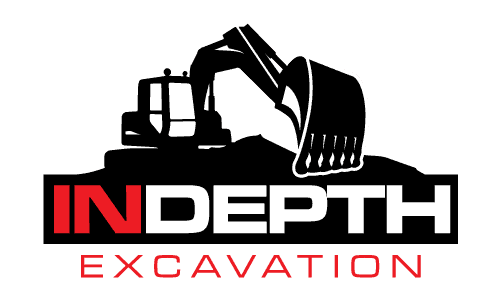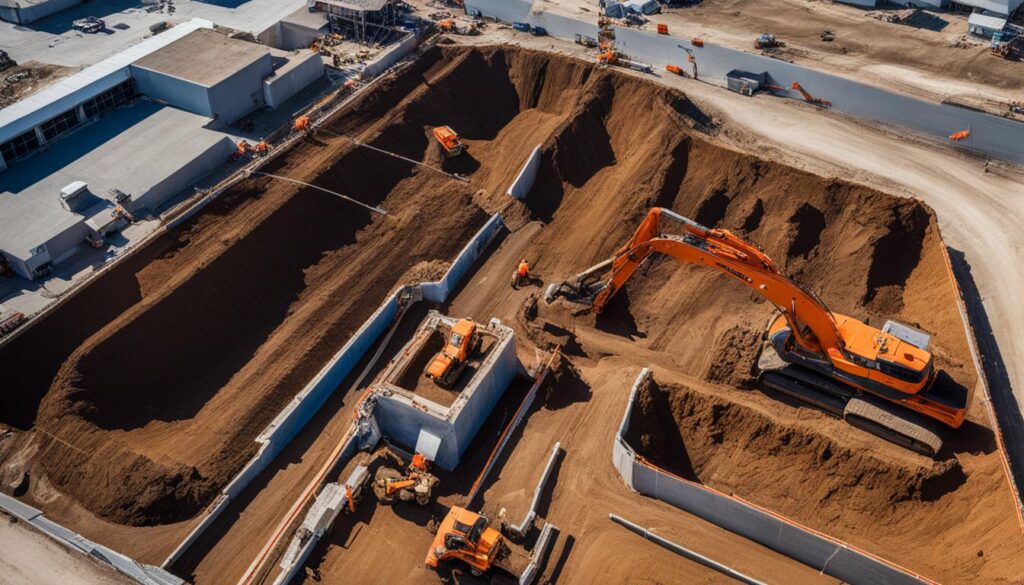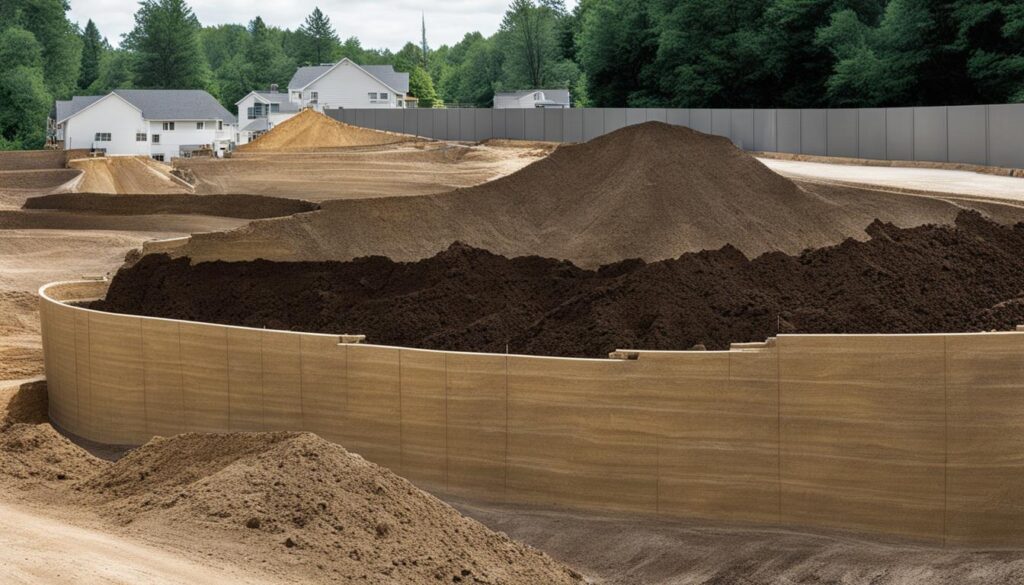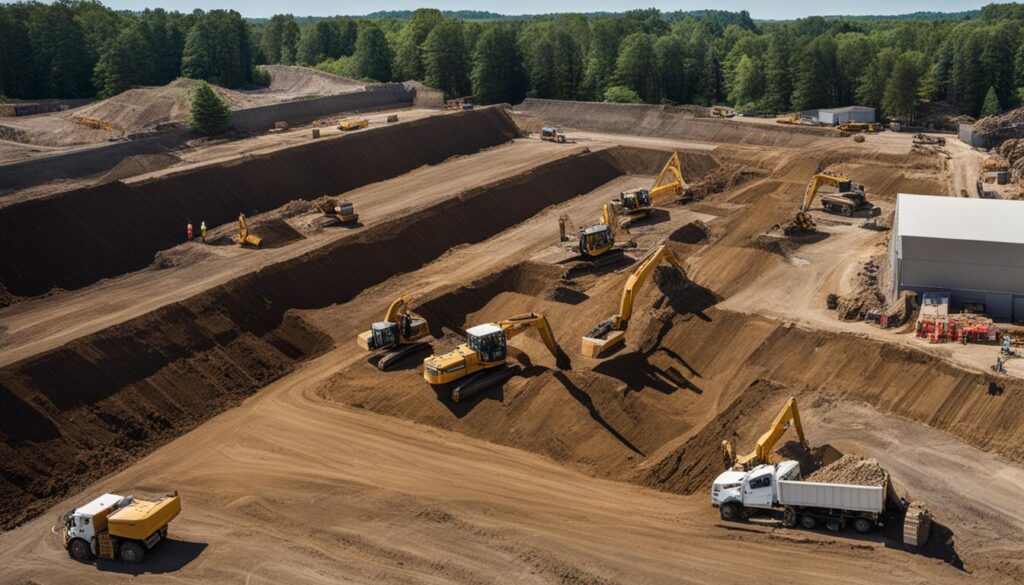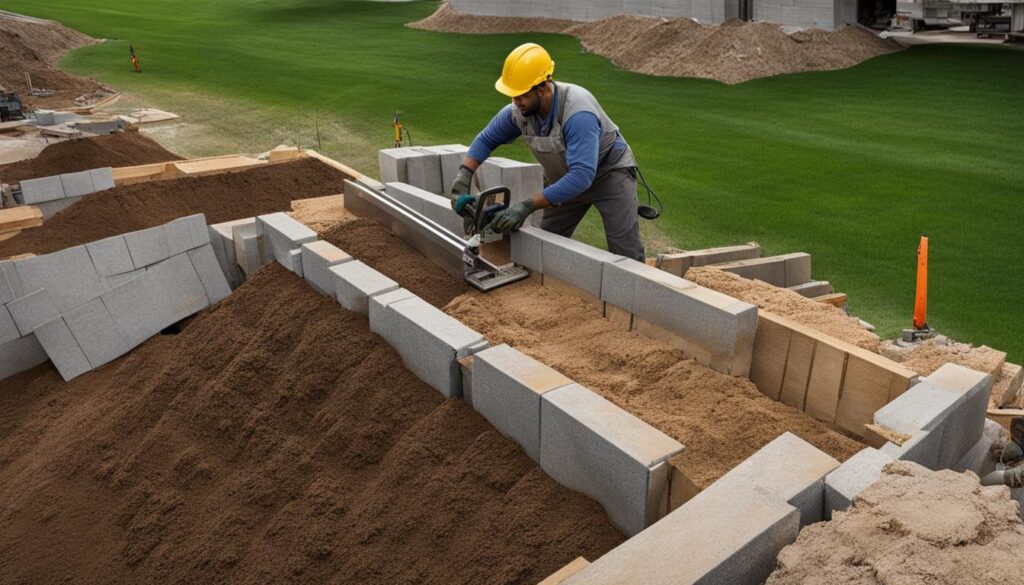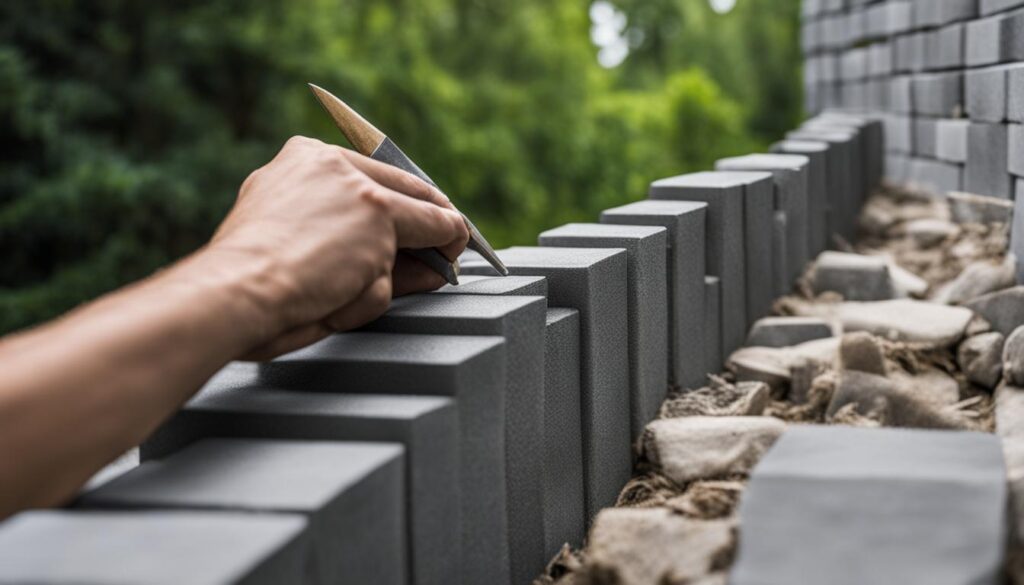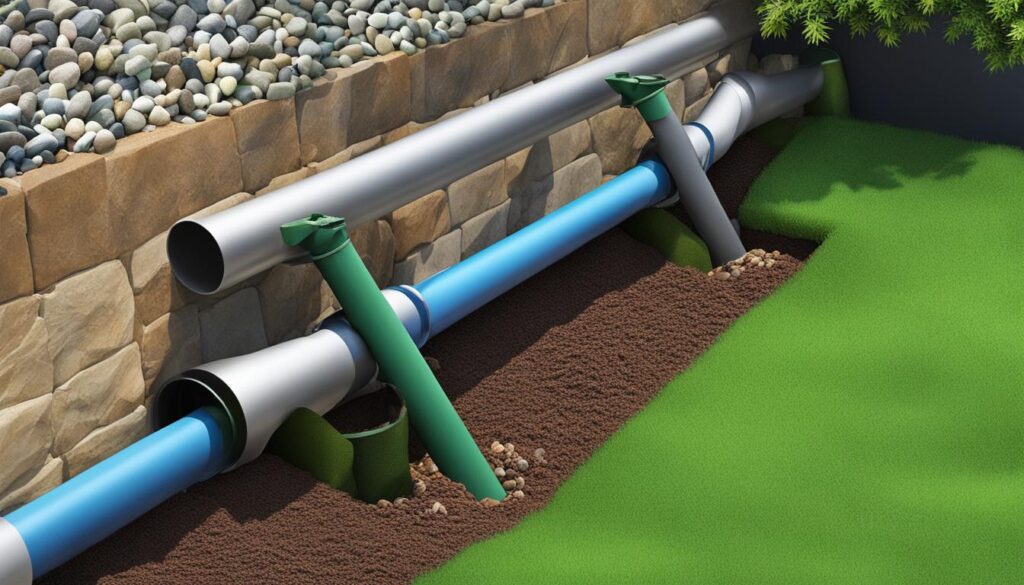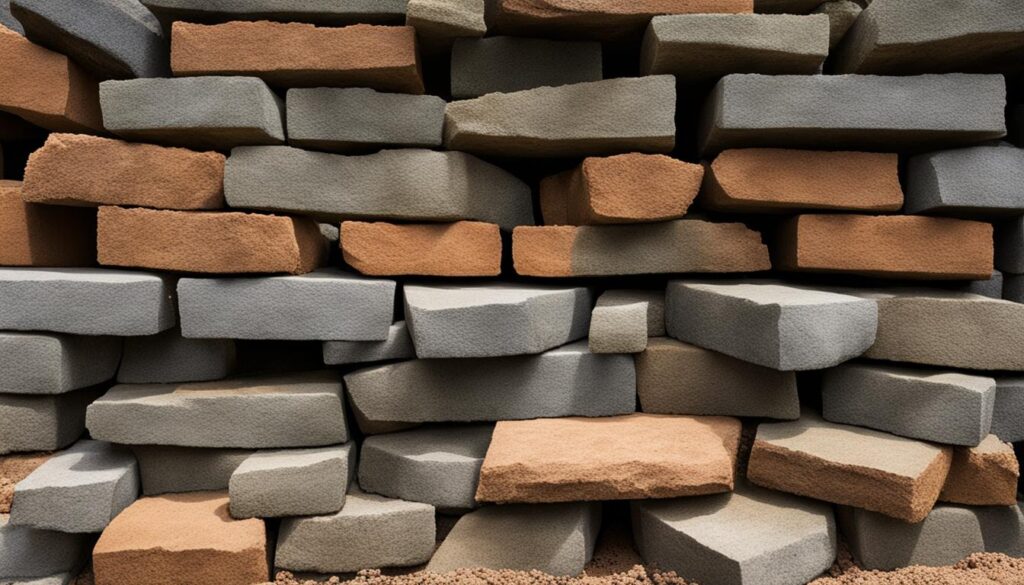Excavating for a retaining wall is a crucial step in creating a strong and durable structure. By properly excavating, you can ensure a solid foundation and adequate drainage, setting the stage for a successful project. In this easy guide, we will walk you through the process of excavating for a retaining wall, providing you with the necessary information to complete the task with confidence.
Key Takeaways:
- Excavation is essential for the stability and longevity of a retaining wall.
- Consider local building codes, permits, and DIY-friendly materials before starting the excavation.
- Proper planning and marking the location of the wall are crucial for accurate excavation.
- A level base and proper backfilling are key to a successful retaining wall installation.
- Optional steps include installing a drainage pipe and adding finishing touches with capstone blocks.
Things to Consider Before Building a Retaining Wall
Before you start excavating for your retaining wall, there are several important factors to consider. These considerations will help ensure that your excavation process goes smoothly and that your retaining wall is built to last.
Check Local Building Codes and Restrictions
Before you begin any construction project, it’s crucial to check your local building codes and restrictions. Depending on your location, you may need to obtain a permit for your retaining wall excavation. Failure to comply with local regulations can result in costly fines and legal issues, so it’s best to do your due diligence before starting the project.
Choose the Right Building Material
When building a retaining wall, it’s important to choose a DIY-friendly building material. Concrete retaining wall blocks are a popular choice due to their durability and ease of installation. These blocks come in a variety of styles and sizes, allowing you to create a custom look for your retaining wall. Additionally, concrete blocks provide excellent stability and can withstand the pressure of the soil behind the wall.
Ensure Proper Drainage
Proper drainage is essential for the longevity and stability of your retaining wall. During the excavation process, make sure to backfill the wall with well-draining gravel or sand. This will allow water to flow freely through the soil, preventing any excess moisture buildup that can damage the structure. Installing a drainage pipe behind the wall is also recommended to further alleviate water pressure and prevent hydrostatic pressure from compromising the wall’s integrity.
Plan for Safety
Excavating for a retaining wall can be a physically demanding task, so it’s important to prioritize safety. Wear appropriate protective gear such as eyewear, boots, and work clothes to safeguard yourself from potential hazards. Additionally, always call 811 to locate underground utility lines before digging to avoid any accidents or disruptions to utility services.
Plan the Location
Before starting the excavation process for your retaining wall, it is important to plan the location carefully. This step ensures that your wall will be positioned correctly, providing stability and functionality to your landscape. Here are the key steps to consider when planning the location:
- Measure and mark: Begin by measuring the length and width of the wall area. Use garden stakes and a mason’s line to mark the boundaries of the wall.
- Level the height: Use a tape measure and string to determine the desired height of the wall. Tie the string to the stakes at the desired height to ensure a level wall.
- Curved walls: If your retaining wall will have a curve, use paint to mark the shape and location. This will help guide you during the excavation process.
By taking the time to plan the location of your retaining wall, you can ensure that it fits seamlessly into your landscape and performs its intended function effectively.
Table: Planning the Location
| Step | Description |
|---|---|
| 1 | Measure and mark the boundaries of the wall area using garden stakes and a mason’s line. |
| 2 | Level the height of the wall by tying a string to the stakes at the desired height. |
| 3 | If the wall will be curved, use paint to mark the shape and location. |
table info: Planning the location of your retaining wall is an important step to ensure accurate and precise excavation. The table above outlines the key steps involved in planning the location of your wall.
Dig a Trench and Level the Ground
Excavating a trench and leveling the ground are crucial steps in preparing the foundation for your retaining wall. By following these excavation techniques, you can ensure a solid and stable structure.
1. Determine the Dimensions of the Trench
Before digging the trench, measure the length and width of your retaining wall. The depth of the trench should be at least half the height of the blocks, with an additional 2-3 inches of base material. The width of the trench should be twice the width of a single block. Mark the dimensions of the trench using stakes and string, ensuring it is straight and even.
2. Dig the Trench
Use a trenching shovel to excavate the trench along the marked dimensions. Start from one end and work your way to the other, removing the soil and creating a uniform depth throughout. Ensure the bottom of the trench is smooth and level by using a standard level or a long straightedge tool.
3. Compact the Trench
After digging the trench, it is essential to compact the soil at the bottom to provide a solid base for the retaining wall. Use a hand tamper or a vibrating plate compactor to compress the soil, ensuring there are no soft spots or uneven areas. Check the levelness of the bottom again and make any necessary adjustments.
4. Verify the Trench Alignment
Before proceeding with the next steps, double-check the alignment and dimensions of the trench. Ensure it is straight and matches the intended design of your retaining wall. This step is crucial for achieving a precise and visually appealing final result.
By following these excavation techniques, you can establish a level base for your retaining wall, promoting stability and long-lasting performance.
| Benefits of Proper Trench Excavation | Common Errors to Avoid |
|---|---|
|
|
Lay the Base
Once the trench for your retaining wall has been excavated to the proper depth, it’s time to lay the base. The base of the retaining wall provides stability and promotes proper drainage. Gravel is the ideal material for the base, as it allows water to flow freely while providing a solid foundation. Choose gravel with stones sized between 1/2 inch and 3/4 inch for optimal results.
To lay the base, fill the trench with a 2-3 inch layer of gravel. Use a rake to distribute the gravel evenly, ensuring that it covers the entire area. Once the gravel is in place, compact it with a tamper. This step is crucial to ensure that the base is evenly compacted, providing a sturdy foundation for the retaining wall.
Remember to wear protective gear such as gloves and safety glasses during this step. It’s important to prioritize your safety while working on any construction project.
Table: Recommended Excavation Depth for Retaining Wall Base
| Retaining Wall Height | Excavation Depth |
|---|---|
| Up to 3 feet | 6-8 inches |
| 3 to 6 feet | 8-12 inches |
| Above 6 feet | 12-18 inches |
“The proper excavation depth for the retaining wall base depends on the height of the wall. It’s important to follow these guidelines to ensure the stability and longevity of your retaining wall.”
By laying a solid and well-compacted base, you are setting the foundation for a structurally sound retaining wall. Once the base is in place, you can proceed to the next step of the construction process, laying the first course of blocks.
Lay the First Course of Blocks
Now that you have prepared the trench and leveled the ground, it’s time to start laying the first course of blocks for your retaining wall. This step sets the foundation for the rest of the wall and requires precision and attention to detail. Follow these steps to ensure a successful installation:
- Begin by placing the first block in the center of your trench. Use a standard level to ensure that the block is level and adjust as necessary.
- Continue placing blocks next to each other, making sure they are snugly fit together. Use a rubber mallet to tap the blocks into place if needed.
- If your blocks have flanges, which are protrusions on the backside of the block, you may need to remove them to create a level surface. Use a hammer and masonry chisel to carefully remove the flanges.
- After laying the first course, fill the space between the wall and the landscape with gravel. This will provide stability and proper drainage for your retaining wall.
- Tamp down the gravel to ensure it is firmly packed and level.
By following these steps, you can lay the first course of blocks for your retaining wall with confidence. Remember to check the levelness of each block and make any necessary adjustments. Taking your time during this phase will set the stage for a sturdy and visually appealing retaining wall.
Table: Cost Breakdown for Retaining Wall Excavation
| Item | Average Cost |
|---|---|
| Excavation Equipment Rental | $100 – $500 per day |
| Labor Cost | $20 – $50 per hour |
| Permit Fees | $50 – $500 |
| Materials (shovel, wheelbarrow, etc.) | $50 – $200 |
| Total | $220 – $1200+ |
“Proper excavation is a crucial step in the construction process for a retaining wall. Taking the time to lay the first course of blocks with precision and attention to detail will ensure a sturdy and long-lasting structure.”
Keep in mind that the cost of excavation for a retaining wall may vary depending on factors such as the size of the project, the location, and the specific requirements of your site. It’s always a good idea to obtain multiple quotes from contractors and suppliers to get an accurate estimate for your project.
Cutting Retaining Wall Blocks
When constructing a retaining wall, it is often necessary to cut the end blocks to ensure a perfect fit and achieve the desired shape. Cutting retaining wall blocks may seem daunting, but with the right tools and techniques, it can be a straightforward process. Remember to always wear the appropriate protective gear, such as safety goggles and gloves, when working with power tools.
Tools and Materials
Before you begin cutting the blocks, gather the necessary tools and materials. You will need:
- Safety goggles
- Gloves
- Tape measure
- Straight edge or level
- Marking pencil or chalk
- Hammer
- Chisel or circular saw with a masonry blade
Once you have these items ready, you can proceed with cutting the retaining wall blocks.
Cutting Techniques
There are a few different techniques you can use to cut retaining wall blocks, depending on the tools available to you and the complexity of the cut:
- Hammer and Chisel: If you have limited tools, you can use a hammer and chisel to make the cut. Begin by marking the desired cut line on the block using a straight edge or level and a marking pencil or chalk. Then, use the chisel to score the block along the marked line. Place the chisel on the scored line, holding it at a slight angle, and tap it gently with the hammer to create a groove. Continue tapping along the groove until the block splits along the line.
- Circular Saw: For more precise cuts or when dealing with thicker blocks, a circular saw with a masonry blade is recommended. Start by marking the cut line on the block as before. Set the blade depth of the circular saw to slightly deeper than the thickness of the block. Position the saw along the marked line and slowly guide it through the block, applying even pressure. Take care to maintain a steady hand and follow the marked line accurately to achieve a clean cut.
Safety Precautions
While cutting retaining wall blocks, it’s essential to prioritize safety. Here are some safety precautions to keep in mind:
- Always wear safety goggles to protect your eyes from flying debris.
- Wear gloves to protect your hands and provide a better grip on the tools.
- Ensure that the work area is well-lit and free from clutter or hazards.
- Take breaks as needed to avoid fatigue and maintain focus.
- Follow the manufacturer’s instructions for the specific tools you are using.
By following these cutting techniques and safety precautions, you can confidently cut retaining wall blocks to achieve the desired shape and fit for your project.
Lay Additional Courses
Once the first course of retaining wall blocks is laid, it’s time to continue building the wall by adding additional courses. However, before proceeding, it’s crucial to ensure that each course is properly leveled to maintain the structural integrity of the wall.
Start by checking the levelness of each block in the first course. Use a standard level to ensure that the blocks are perfectly horizontal. If any adjustments are needed, gently tap the blocks with a rubber mallet until they are level.
Once the first course is level, you can proceed with laying the subsequent courses. Before placing each block, make sure to brush off any debris that may interfere with the proper alignment. Additionally, ensure that each block is securely seated against the previous course to maintain stability.
| Steps for Laying Additional Courses of Retaining Wall Blocks |
|---|
| 1. Check the levelness of each block in the first course using a standard level. |
| 2. Brush off debris from the first course and clean the area. |
| 3. Place each block securely against the previous course, ensuring a tight fit. |
To further enhance the stability of your retaining wall, consider installing a drainage pipe behind the wall every 25-50 feet. This will help prevent water buildup and potential damage to the structure. Cover the pipe with gravel to ensure proper drainage.
As you continue laying the additional courses, it’s important to periodically check the levelness of each course to ensure a straight and even wall. Pay attention to any deviations and make necessary adjustments to maintain the desired levelness.
Install Drain Pipe (Optional)
Proper drainage is a crucial aspect of a well-designed retaining wall. Installing a drain pipe behind the wall can help prevent water buildup and potential damage to the structure. This optional step is particularly important in areas with heavy rainfall or poor soil drainage. By following these instructions, you can effectively install a drain pipe for your retaining wall.
Materials and Tools Needed:
- Perforated corrugated pipe
- Drain sleeve
- Gravel
- Shovel
- Tape measure
1. Determine the length of your retaining wall and purchase a perforated corrugated pipe of appropriate size. The pipe should be long enough to extend the entire length of the wall.
2. Dig a trench behind the retaining wall, ensuring it follows the slope of the wall. The trench should be deep enough to accommodate the pipe and wide enough to allow for easy installation.
3. Place the perforated corrugated pipe in the trench, ensuring that it is positioned with the perforations facing down. This allows water to enter the pipe while preventing soil from clogging the perforations.
4. Cover the pipe with a drain sleeve to further protect it from sediment and debris. The drain sleeve acts as a filter, preventing the pipe from becoming clogged and ensuring proper water flow.
5. Backfill the trench with gravel, compacting it gently as you go. The gravel provides additional drainage and stability to the retaining wall.
Continue with the remaining steps of the retaining wall construction process, such as laying additional courses of blocks and backfilling the area behind the wall. In areas with heavy rainfall or poor drainage, the installation of a drain pipe can significantly enhance the performance and longevity of your retaining wall.
Backfill the Wall
After laying all the courses of retaining wall blocks, it’s time to backfill the area behind the wall. Backfilling is an important step that helps provide additional stability and support to the structure. It also helps with proper drainage and prevents erosion. Here’s how to effectively backfill your retaining wall:
- Start by filling the space behind the wall with gravel or sand. Using a shovel or a rake, distribute the backfill material evenly, ensuring that it reaches all areas behind the blocks.
- Tamp down the backfill material using a hand tamper or a vibrating plate compactor. This will help remove any air pockets and ensure that the material settles firmly.
- Continue backfilling until you reach slightly below the height of the wall. This will allow space for adding a layer of well-draining soil mix on top.
- Fill the remaining space with the well-draining soil mix. This can be topsoil or sod if you plan on growing grass or plants in front of the wall.
Remember to thoroughly compact each layer of backfill material to avoid any future settling or shifting of the retaining wall. This will help maintain the structural integrity of the wall over time.
Tip: Proper backfilling is crucial for the long-term stability of your retaining wall. Take your time to ensure the backfill material is evenly distributed and firmly packed. This will help prevent any potential issues down the line.
By following these steps, you can successfully backfill your retaining wall, completing the construction process. The backfill material will provide additional support and prevent any potential damage or erosion behind the wall. Now that your wall is properly backfilled, you can move on to the finishing touches to add the final aesthetic and functional elements to your retaining wall.
| Materials | Tools |
|---|---|
| Gravel or sand | Shovel |
| Well-draining soil mix | Rake |
| Hand tamper or vibrating plate compactor | Tape measure |
Finishing Touches
Now that the main structure of your retaining wall is complete, it’s time to add the finishing touches that will enhance its visual appeal and functionality. One important element to consider is the addition of capstone blocks. Capstones provide a polished look to the top of the wall and also help protect it from water damage. They come in various styles and sizes, allowing you to choose the one that best complements your overall design.
To install the capstones, start by thoroughly cleaning and preparing the top surface of the wall. Remove any debris, dirt, or dust to ensure a smooth and even application. Apply a high-quality construction adhesive to the top of the last course of blocks, following the manufacturer’s instructions. Carefully place the capstone blocks on the adhesive, pressing them firmly into place. Use a level to ensure they are aligned and even. Allow the adhesive to dry completely before moving on to the next step.
Once the capstones are securely in place, consider restoring the area in front of the wall. Replace any topsoil or sod that may have been removed during the excavation process. This will not only create a seamless transition between the wall and the surrounding landscape but also help prevent erosion and provide a visually pleasing finish. You may also want to add additional landscaping elements such as flowers, shrubs, or decorative rocks to further enhance the aesthetics of your retaining wall.
Table: Comparison of Different Capstone Block Styles
| Style | Material | Size | Price |
|---|---|---|---|
| Smooth | Concrete | 12″ x 4″ x 8″ | $10 per block |
| Natural Stone | Stone | 14″ x 6″ x 10″ | $20 per block |
| Tumbled | Concrete | 16″ x 8″ x 12″ | $15 per block |
When selecting capstone blocks, consider factors such as your budget, desired aesthetic, and the overall style of your retaining wall. It’s important to choose a style that complements the existing elements in your landscape and creates a cohesive look. Additionally, ensure that the capstone blocks are of high quality and durable, as they will be exposed to the elements and should withstand weathering over time.
Conclusion
In conclusion, constructing a retaining wall requires proper excavation to ensure stability and longevity. This easy guide has provided you with the necessary steps and information to successfully excavate for a retaining wall. By considering important factors such as building permits, choice of materials, proper drainage, and safety precautions, you can create a sturdy and lasting structure.
Remember to plan the location, dig a trench, and level the ground before laying the base and the first course of blocks. Stagger the blocks and continue laying additional courses, ensuring each block is level and securely seated. If needed, install a drainage pipe behind the wall and backfill the area with gravel or sand. Finish your retaining wall by adding a layer of capstone blocks and consider adding landscaping elements to enhance its overall appearance.
By following this retaining wall construction guide, you can create a beautiful and functional structure that will provide the necessary support and protection for your landscape. So, get started on your project and enjoy the benefits of your newly excavated, constructed, and finished retaining wall!
FAQ
Do I need a permit to excavate for a retaining wall?
Check your local building codes and restrictions to determine if you need a permit for your project.
What building material is best for a DIY-friendly retaining wall?
Choose concrete retaining wall blocks as they are easy to work with for DIY projects.
How do I ensure proper drainage behind the retaining wall?
Backfill the wall with well-draining gravel or sand and install a drainage pipe.
When is the best time to build a retaining wall?
Plan to build the wall during a dry period to ensure optimal conditions.
How do I locate underground utility lines before digging?
Always call 811 to have underground utility lines located before beginning excavation.
What is the first step in excavating for a retaining wall?
The first step is to plan the location by measuring and marking the area.
How do I ensure a level base for the retaining wall?
Use a trenching shovel to dig a trench and then compact the bottom with a tamper.
What should the base of the retaining wall be made of?
The base should be made of gravel for stability and proper drainage.
How do I lay the first course of retaining wall blocks?
Start in the center of the trench and ensure each block is level and securely seated.
How do I create a curved retaining wall?
Paint the shape and location of the wall if it will be curved.
Should I install a drainage pipe behind the retaining wall?
Installing a drainage pipe is optional, but it can help with proper drainage in areas with heavy rainfall.
How do I backfill behind the retaining wall?
Backfill with gravel or sand, ensuring it is evenly distributed and tamped down for stability.
How do I finish the retaining wall?
Add a layer of capstone blocks and secure them with construction adhesive for a finished look.
